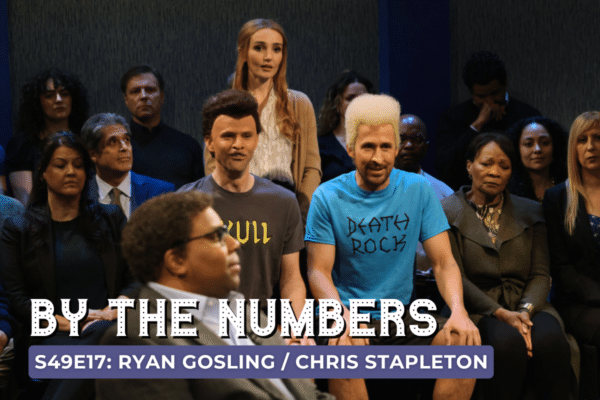
Opening in theaters today, a new film set in the world late-night television answers the burning question: Could a late-night show beat Johnny Carson in the ratings if it its surprise guest turned out to be Satan?
Late Night with The Devil is an independent film, as many horror movies are, made in Australia, with mostly unknown Australian actors; but its look and many of its characters will be familiar to anyone in America who has watched late-night TV, especially during the Carson-dominant era of the 1970’s.
This is far from the first time the genre of late night has inspired fictionalized versions of itself in the movies or in other quarters of television. There are many memorable entries in this subsection of entertainment, headed in TV certainly by one of the greatest comedies of all time, The Larry Sanders Show, and in films by Martin Scorsese’s most underrated movie, The King of Comedy.
But others come to mind, including Mindy Kaling’s insightful musing (she wrote and acts in the film) on a fantasy world where a woman could actually have been a long-term late night star (Late Night, starring Emma Thompson). And a late-night show is central to the plot in the Batman-adjacent film Joker, which won an Oscar for Joaquin Phoenix.
Late Night with The Devil may be the most late-night centric of them all in one sense, because the action takes place entirely on the set of a fictional 1970’s late-night entry called Night Owls, during one memorable episode (though un-aired and previously never seen).
And while comedy is not ever the point, it is laugh-out-loud funny in many moments, where satire meets camp somewhere in the trip over the top.
The framework is in the “found footage” department of horror (The Blair Witch Project, et al). The lost episode of Night Owls from a Halloween night in 1977 documents the desperation of host Jack Gilroy, a thickly side-burned also-ran to Carson, as he tries to save his show by staging a perhaps-real, perhaps-staged interaction between a parapsychologist (who happens to be having an affair with the host) and a young girl she claims to be possessed by a demon named Mr. Wiggles.
Obviously things go wildly off the rails. Right there, live on tape, with the band playing tunes out of the commercials and the audience hanging around in their seats clapping along even after scenes reminiscent of The Exorcist and Alien play out in front of them. (The implied message: “Shall we see if we can get this cute little girl to turn into a devil-possessed gorgon right here on our stage? Sure why not? Stick around after these messages.”)
At various points, Jack (played by David Dastmalchian, an American actor known for his supporting roles in nine different Marvel and DC movies) interacts with his schmo-like announcer Gus and his chain-smoking, amoral producer Leo, both tropes straight from Larry Sanders (though much less amusing.)
Tropes abound, in both the many allusions to other horror movies, and also in the familiar late-night guest types, like the foreign-accented psychic (a la Uri Gellar) and the professional debunker (The Amazing Randi). The set actually looks more like “The Mike Douglas Show” than a late-night show, and the action borrows much more heavily from shows like Jerry Springer than David Letterman, but lots of failed syndicated late-night shows looked similarly cheesy.
The film has picked up some legit buzz. The New York Times review called Late Night with The Devil diabolical fun, and no less a horror luminary than the great Stephen King called it “absolutely brilliant.”
Does it say anything about late-night television? Less than any of those classic examples, for sure, because Night Owls never feels like a late-night show that would have lasted a month on the air (even Pat Sajak’s CBS show lasted longer than that.)
Kaling’s Late Night film got into the writer’s room, and other inside elements of a late-night show, while Thompson was genuinely credible as a woman who somehow defied reality and carved a career in late night.
King of Comedy delved uncomfortably deep into the career-defining opportunity that Carson’s show presented to stand-ups. Robert DeNiro found one of his most arresting, semi-disturbed characters in the unforgettably named Rupert Pupkin, who is so convinced of his comedy talent, and so hurt by the ersatz Tonight Show’s refusal to give him a shot that he kidnaps the pseudo-Johnny (“Jerry Langford” played by Jerry Lewis) and holds him hostage until he can get his six minutes or so center stage.
Many comics at the time revealed they sort of identified with Rupert’s desperation. The film unfolded far more realistically—right down to Rupert pulling off the performance despite previously seemingly deluded about his talents—than the plot outline might have made it seem.
What was extraordinary in Joker was how it played almost like a sequel to King of Comedy, with DeNiro returning, now as the host (named Murray Franklin, but surely suggesting this could be a now-successful Rupert decades later). Murray is confronted by a much crazier would-be comic, the violently deranged Joker. And the laughs stop abruptly.
In Late Night with The Devil? Same.
Laughs really are not written in as much as they are organic to the bonkers goings-on. But the late-night ambience provides the familiar scaffolding for a mostly conventional horror movie to take a flying leap.
Late Night with The Devil opens in theaters nationwide today, Friday March 22nd. It will premiere on the horror-themed streaming service Shudder April 19th.











